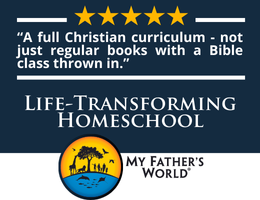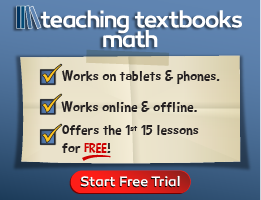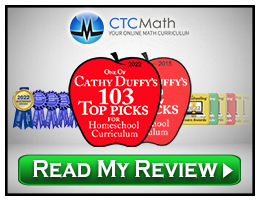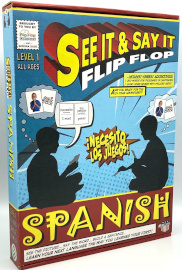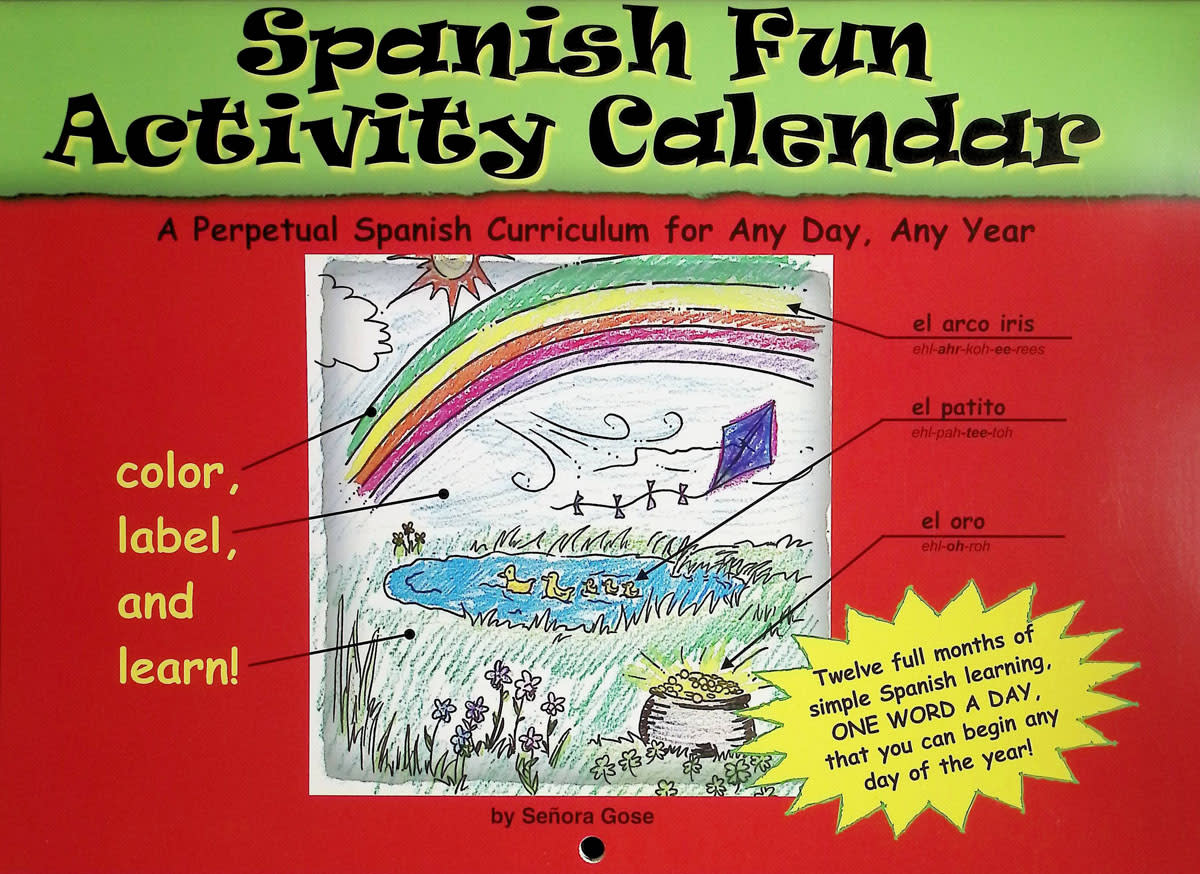Flip Flop Spanish was written by a teacher based upon her work teaching group classes including children of varied ages—the ordinary homeschool situation. The idea was to create a program usable for children as young as three that could be taught by a parent or teacher with no knowledge of Spanish.
Flip Flop Spanish has several resources that you might use, and you probably won’t use all of them. Instead, select those most suitable for your children’s ages and learning styles. The workbooks with MP3 audio files and See It and Say It (Level 1 and Level 2) all incorporate activities to suit the three learning modalities—listening activities, visual activities, and hands-on activities, but you can spend more or less time on the different types of activities. Descriptions of the various options and how they might work together should help you decide.
See It and Say It Flip Flop Spanish
See It and Say It is a full curriculum that can be used with all ages. Level 1 and Level 2 each take two years to complete, although older students should be able to complete two lessons in a sitting and can finish the courses in half the time.
Both levels have a guidebook with detailed plans for lessons three times a week. Each level can be purchased as a completely digital set (flashcards purchased separately); a boxed set (printed guidebook and three sets of flashcards, a whiteboard paddle with marker, MP3 audio files, and flashcard sleeves); or a bundle that includes digital guidebook, MP3 files, printed flashcards, and whiteboard paddle. Level 2 includes a moveable clock face and a spinner in place of the whiteboard paddle.
The guidebook comes as loose-leaf pages for you to put into your own binder. Following instructions in the manual you use the audio files on the USB drive and three sets of flashcards as the primary teaching tools. (Flashcards included in the See It and Say It sets are also available separately for those who want to use them along with the workbooks.) Flashcards have full-color images on one side. On the reverse are the words in Spanish (including the appropriate article for nouns, e.g., el tenedor), the phonetic pronunciations, and the English meanings.
Parents and children should work together through the lessons, listening to the audio files, identifying the appropriate cards, saying the words, and then saying sentences as they put cards together. After listening through lessons, the parent presents the same lesson from the teacher manual without the audio files.
Younger children will work only with the picture sides of the cards at first. Older students might work with both picture and word sides of the cards. You will need to pause the audio files frequently as students puzzle out how to construct sentences and practice saying them. On the other hand, “speed rounds” on the audio files challenge students to quickly identify cards.
The instructor, Señora Gose, gradually introduces extra Spanish vocabulary such as ¿Donde está? and the words aquí and cuidado as instructional words and phrases even though these are not on the flashcards. Also, you will need to obtain your own cardstock to create some additional flashcards without illustrations for words such as y, pero, es, me, los, and algo; cards with hand-drawn pictures of things such as an equal sign, a boy, and a girl; and color cards. There are quite a few of these cards to create, so I recommend cutting cards from cardstock to the same size as the pre-printed cards so that they align easily with each other for use and for storage. While I would prefer to have these cards provided with the set rather than having to create them, if students help create them, this can reinforce learning.
After the first few weeks, students will begin to identify their cards as nouns, verbs, and adjectives by drawing borders on their cards with different colored permanent markers.
Students frequently construct their own sentences and responses, which challenges them to apply what they are learning. Students begin combining two cards in the first lesson and five cards in the second to form Spanish sentences. They start with a limited number of words, but they use those words over and over in various combinations. Sentences can expand to become quite lengthy as students learn more and more vocabulary words.
Older students (ages eight and up) should write to reinforce their learning. They will write words and definitions as well as sentences, but they do this in their own notebook (called a “personal learning dictionary”). It is up to parents to determine how much writing they need to do. Crossword puzzles also reinforce vocabulary and writing for older students.
Included in the See It and Say It Level 1 set are a wipe-off paddle (that looks like a ping pong paddle) and a wipe-off marker that are used for reinforcement games. Some other learning activities are presented as games, generally using the flashcards. Some activities work better if you have two or more students at similar skill levels competing with each other, but most can be done with a parent and child.
Grammatical elements are gradually introduced, so while this is a conversational-style program, some grammar is taught within the lessons and it includes grammar notes for parents that they might present to students if appropriate. The concept of verb conjugations is introduced toward the end of the course, teaching the conjugation of ir (to go): voy, vas, va, vamos, vaís, and van. But the instructions tell parents to emphasize only voy and vamos (I’m going and we’re going) rather than expect children to master all of the forms.
While the courses are great as an introduction to Spanish for the elementary grades and even for older students, it lacks some of the grammatical components required for high school credit.
Workbooks with audio files
There are three digital workbooks available. Two are labeled as appropriate for ages 3 to 5 and one is labeled for ages 6 to 9. While the Level 1 and Level 2 books for ages 3 to 5 both direct children to write Spanish words, these lessons are actually meant to be done as narration/dictation with the parent doing the writing rather than the child. There are some exercises with numbers and colors that might be too difficult for some young children. If I had not noticed a suggested age range, I would have suggested a target audience of about ages 6 to 10. Younger children certainly can be taught from these books as long as parents do the writing and select activities appropriate for each child's age and ability, and older children should do their own writing in the books for ages 3 to 5.
The book labeled as appropriate for ages 6 to 9—again titled Level 1, but for that age group—should be suitable for students up through about age 11, in my opinion.
The workbooks have an unusual format with lessons printed only on the right-hand pages; after students reach the end of the book, they flip it over and continue with the other half of the lessons printed only on the right-hand pages in reverse—thus the name Flip Flop. This means children are always working on only a single page at a time.
Students read and write in the text if they are able. These black-and-white books often give students opportunities to color in illustrations and sometimes label them. Activities include matching, fill-in-the-blanks, circling, a crossword puzzle (in the older level book), and drawing.
Parents also use the workbooks to direct interactions such as conversations, guessing games, body movements, games, and songs. Each book has a glossary and a relatively small number of flashcards to be cut out. (There are only twelve flashcards in the first book. See my description of the more useful sets of flashcards below.)
MP3 audio files are used for listening and speaking practice with the new words, phrases, and sentences. The audio files also direct students to perform some interactive conversations and to use gestures and expressions as they speak.
The lower-level books and audio files introduce vocabulary and usage but very little grammar. Older students are taught helpful grammatical concepts as needed, but this is essentially a conversational rather than a grammar-based approach.
Books are relatively brief. Each lesson should take a week to complete, and there are three or four activities within each lesson. A daily lesson in the younger-level books should take from five to fifteen minutes while those in the upper-level book might take ten to twenty minutes each. The lower-level books have fourteen lessons each while the upper level has sixteen.
Supplemental Items
As I mentioned previously, the flashcards are sold separately as well as within the See It and Say It sets. I highly recommend that you get the flashcards to use along with the workbooks and audio files.
The Spanish Fun Activity Calendar has space for writing the current year’s dates for each month. Each day on the calendar features a word or phrase, its pronunciation, and its translation; this is a great way to practice each day, even through the summer and holidays.
Bella: A Bilingual Reader presents the story of a hermit crab named Bella in English. Flip the book over and upside down to read the same story in Spanish. The level of the Spanish vocabulary is rather challenging so you might find the Spanish version difficult to read with the limited teaching in these courses. Tiago la tortuga is a second bilingual reader.
Flip Flop Spanish Vocabulary Builder: Movie Magic (which I have not reviewed) sounds like a great way to practice Spanish with movies. Señora Gose shows you how to run popular children’s movies such as “Dumbo” in Spanish in a way that helps children listen for vocabulary that they know. Familiar movies make it much easier for children to follow along.
Summary
The way the courses are designed makes them very practical for group or family learning, but they will also work for a parent teaching just one child.
The mix of activities offered by Flip Flop Spanish makes it a great choice for children up through the elementary grades. You can select the resources that best suit the needs of your learners. If you want more reading and writing, you might choose the workbooks with audio files. Otherwise, See It and Say It might be better. Even with See It and Say It, you can incorporate writing activities for older students.
Note: Catherine Levison, the author of A Charlotte Mason Education, recommends Flip Flop Spanish for those seeking a Charlotte Mason approach to foreign language.

